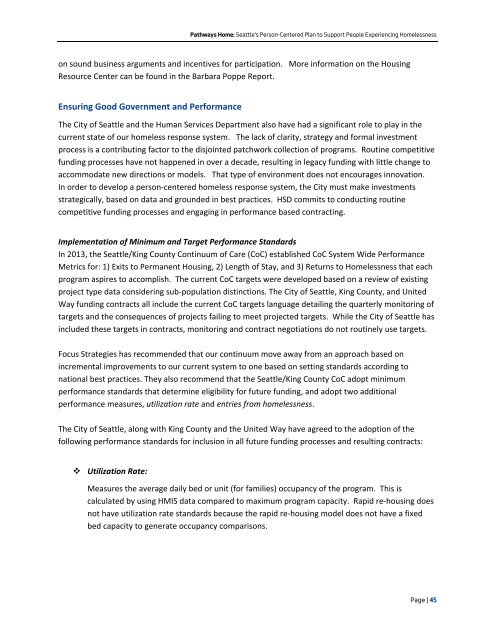ActionPlan
ActionPlan
ActionPlan
You also want an ePaper? Increase the reach of your titles
YUMPU automatically turns print PDFs into web optimized ePapers that Google loves.
Pathways Home: Seattle’s Person-Centered Plan to Support People Experiencing Homelessness<br />
on sound business arguments and incentives for participation. More information on the Housing<br />
Resource Center can be found in the Barbara Poppe Report.<br />
Ensuring Good Government and Performance<br />
The City of Seattle and the Human Services Department also have had a significant role to play in the<br />
current state of our homeless response system. The lack of clarity, strategy and formal investment<br />
process is a contributing factor to the disjointed patchwork collection of programs. Routine competitive<br />
funding processes have not happened in over a decade, resulting in legacy funding with little change to<br />
accommodate new directions or models. That type of environment does not encourages innovation.<br />
In order to develop a person‐centered homeless response system, the City must make investments<br />
strategically, based on data and grounded in best practices. HSD commits to conducting routine<br />
competitive funding processes and engaging in performance based contracting.<br />
Implementation of Minimum and Target Performance Standards<br />
In 2013, the Seattle/King County Continuum of Care (CoC) established CoC System Wide Performance<br />
Metrics for: 1) Exits to Permanent Housing, 2) Length of Stay, and 3) Returns to Homelessness that each<br />
program aspires to accomplish. The current CoC targets were developed based on a review of existing<br />
project type data considering sub‐population distinctions. The City of Seattle, King County, and United<br />
Way funding contracts all include the current CoC targets language detailing the quarterly monitoring of<br />
targets and the consequences of projects failing to meet projected targets. While the City of Seattle has<br />
included these targets in contracts, monitoring and contract negotiations do not routinely use targets.<br />
Focus Strategies has recommended that our continuum move away from an approach based on<br />
incremental improvements to our current system to one based on setting standards according to<br />
national best practices. They also recommend that the Seattle/King County CoC adopt minimum<br />
performance standards that determine eligibility for future funding, and adopt two additional<br />
performance measures, utilization rate and entries from homelessness.<br />
The City of Seattle, along with King County and the United Way have agreed to the adoption of the<br />
following performance standards for inclusion in all future funding processes and resulting contracts:<br />
Utilization Rate:<br />
Measures the average daily bed or unit (for families) occupancy of the program. This is<br />
calculated by using HMIS data compared to maximum program capacity. Rapid re‐housing does<br />
not have utilization rate standards because the rapid re‐housing model does not have a fixed<br />
bed capacity to generate occupancy comparisons.<br />
Page | 45


